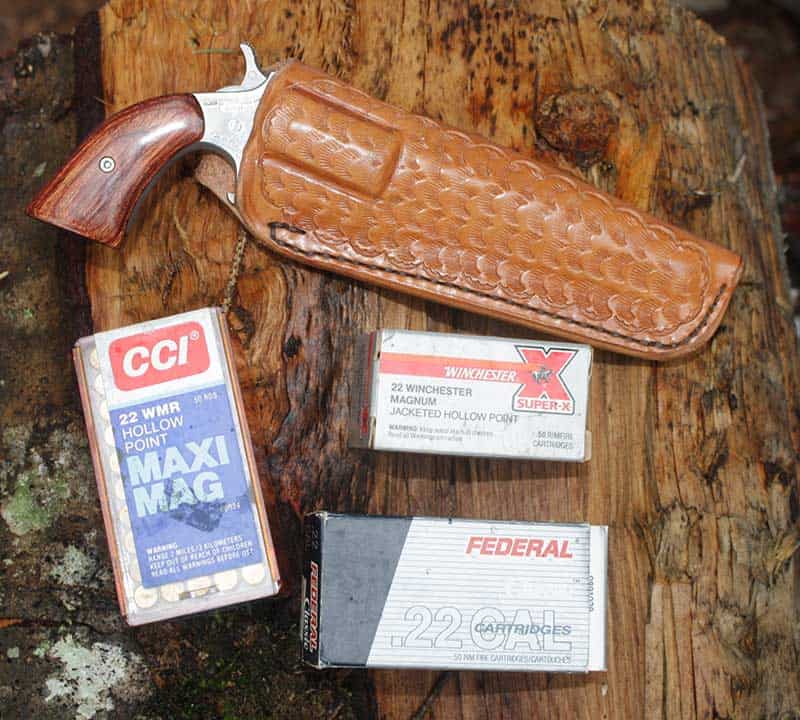Pocket Power
Five Rounds Of .22 Magnum Beats "Help Me" Anytime
Many years ago, I acquired one of North American Arms’ primo 5-shot single-action mini-revolvers, considered by some to be a novelty and by others to be a potential lifesaver, and the one in my possession is part of both thoughts, along with some nostalgia.
My specimen is a model dubbed “The Earl,” a smallbore facsimile of an old Remington revolver with that telltale wedge below the barrel extending forward from the frame, under the barrel out to a point about one inch back from the muzzle. My wheelgun came with two cylinders, one for standard .22 Long Rifle cartridges and the other chambered for .22 Magnums. Whenever I carry this little pocket rocket, the magnum cylinder is installed, stoked with either Federal, Winchester or CCI cartridges.
The Earl has a 4-inch barrel topped by a small pin/post-type front sight. The rear sight is a simple notch at the rear of the frame. There is no trigger guard, and I carry this little shooter with all chambers loaded and the hammer down so the firing pin rests in a small notch positioned between two chambers. It’s actually a very reliable safety feature, in my opinion.
Why would anyone carry a tiny revolver chambered for a rimfire cartridge for personal protection? Check the ballistics for the .22 WMR cartridge. If the unfortunate occasion should arise that I might have to use this little wheelgun in an emergency, whatever is on the receiving end of that bullet is going to hurt.
My recent visit to the range to chronograph some rounds produced acceptable velocities ranging to more than 1,200 fps out of my 4-inch barreled gun. Published ballistics on these rounds — fired from a rifle, presumably — are more impressive, reaching to the 1,900 fps realm. A 40-grain projectile — especially a hollowpoint — can deliver terminal stopping power on small game, and I’ve read accounts over the years about people using the tiny magnum to dispatch treed bobcats or even mountain lions, rabbits and other small game. Well-placed bullets in the noggin can definitely be fatal.
Because this little round gun has no trigger guard and an exposed hammer, some might suggest it could be prone to unintended discharges. With its 4-inch octagonal barrel, I’ve seen it argued this is not a pocket gun, but that depends upon the size of the pocket and whether it is on your trousers or in a cover vest of some sort. I have carried this handgun in the pocket of a 5.11 Tactical vest, and nobody was any the wiser.
Aim Low, Hit High and Hard
With a target set at 15 feet, my tiny rimfire can shoot some very tight groups, but I’ve noticed it shoots high at that distance by about 2.5 inches. That is just fine with me, because windage is very good, and aiming slightly low will still make a nasty hole where it will do the most good.
I suppose installing a taller front sight would bring my shots down some, but honestly, it doesn’t bother me that this palm-sized powerhouse shoots a little high. At the typical range for this revolver’s intended purpose, it’s not going to make much difference.
Holding down with the front sight aimed just below the center ring of my target, I stacked a nice group just above the bullseye. I could probably do that all day because even if it sends bullets high, the NAA Earl is as reliable as they come, and thanks to its stainless-steel construction, it cleans up nicely with a bit of Hoppe’s No. 9.
I have noticed the gun gets a little cranky after running three- or four-cylinder loads, making reinsertion of a loaded cylinder a little messy. There is definitely a problem with power residue, but not so much it makes the Earl malfunction.
Muzzle flash is impressive, even in just subdued light. In the full darkness, it looks like a rather large firecracker going off.
Although I’ve had it for several years, I started carrying the NAA Earl as a backup about two months ago. Even though it is a chore to reload — first one has to pull the cylinder out of the frame, knock out the empties either using the cylinder pin (in my estimation, that pin is too fragile for the job), then reloading either from a box or from your pocket, then reinstall the cylinder — having the gun in my deep vest pocket at least gives me a reliable survival tool in an emergency.
Lucky Find
While rummaging around in my workshop, I came across four unopened boxes of .22 Magnums, which added to the boxes I had in the house, so there is plenty of ammunition for practicing a bit. A quick inventory indicates I’ve got in the neighborhood of about 400 rounds, and to be honest, I can’t recall when I bought this stuff, but since none of the boxes had been opened, it’s like new and it shoots swell.
One thing I couldn’t find was a holster to carry the Earl in while I might be on a walk somewhere a bigger gun just might alarm the neighborhood. (Of course, I can pack a bigger gat in an IWB rig under a cover garment; that’s not the point.) So, I found a piece of scrap leather just big enough to fold around the Earl and went to work. About an hour’s worth of work solved the holster problem, making sure the mouth of the rig covers the trigger. I gave it a light finish of leather sheen, but I might give it a soaking in Neatsfoot oil just to give the leather some added protection.
Surprisingly, fired from the Earl, a full-house .22 Magnum did not seem to produce much recoil. Indeed, I found shooting the little handgun to be relatively comfortable, despite the small grip, and for a gun of this size, the trigger on my piece isn’t too bad.
I actually plan to carry the Earl while hunting small game later this fall, just to see whether I can plug a rabbit or late-season grouse. Meanwhile, I’ll keep an eye peeled for ammo sales and maybe pick up a couple more boxes of .22 Magnum 40-grain hollowpoints.
Mass Exit
In case you missed it early last month, Smith & Wesson essentially had enough of Massachusetts’ hostility toward firearms and finally finished a move which began two years ago, and ended with corporate relocation to Maryville, Tennessee.
Back in 2021, S&W was completely up front about its plans. Perhaps a little trip down memory lane will refresh everyone’s memory. The Sept. 30, 2021 announcement from S&W President and CEO Mark Smith could not have been more clear.
“This has been an extremely difficult and emotional decision for us,” Smith said, “but after an exhaustive and thorough analysis, for the continued health and strength of our iconic company, we feel that we have been left with no other alternative.”
According to the news release, Smith “specifically cited legislation recently proposed in Massachusetts that, if enacted, would prohibit the company from manufacturing certain firearms in the state.” What anti-gun politicians in Massachusetts tried to peddle as their moral high ground will turn out to revenue loss.
“These bills would prevent Smith & Wesson from manufacturing firearms that are legal in almost every state in America and that are safely used by tens of millions of law-abiding citizens every day exercising their Constitutional 2nd Amendment rights, protecting themselves and their families, and enjoying the shooting sports,” Smith explained. “While we are hopeful that this arbitrary and damaging legislation will be defeated in this session, these products made up over 60% of our revenue last year, and the unfortunate likelihood that such restrictions would be raised again led to a review of the best path forward for Smith & Wesson.”
Here was the kicker: S&W checked out several locations in several states and decided to “relocate 750 jobs and its headquarters to Maryville.” These were the key factors:
• Support for the 2nd Amendment
• Business-friendly environment
• Quality of life for employees
• Cost of living and affordability
• Access to higher education institutions
• Availability of qualified labor for its operations and headquarter functions
• Favorable location for efficiency of distribution
Those 750 jobs are a gain for Tennessee and a loss for Massachusetts. Think lost B&O revenue, lost payroll taxes, lost consumer spending with Bay State businesses. Massachusetts may not realize it yet, but the state lost something important.
This isn’t the first time a major American firearms company has told one state “goodbye” and moved its operation elsewhere. Weatherby picked up and moved from California to Wyoming. Remington moved its headquarters from Ilion, New York to Georgia.
Nobody can say Smith wasn’t absolutely honest about the move and the reasons behind it.
There is no small irony in the fact that Connecticut, which is also making things tough on gun owners and makers, is nicknamed “the Constitution State.” The state motto in Massachusetts is “By the sword we seek peace, but peace only under liberty.”









